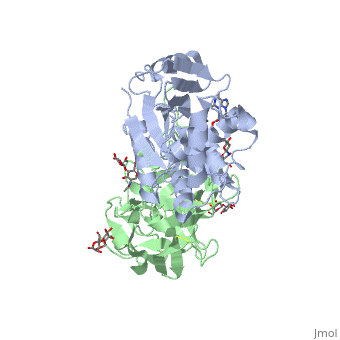Sandbox Reserved 1359
From Proteopedia
(Difference between revisions)
| Line 1: | Line 1: | ||
==Ricin== | ==Ricin== | ||
<StructureSection load='3rtj' size='340' side='right' caption='Ricin' scene=''> | <StructureSection load='3rtj' size='340' side='right' caption='Ricin' scene=''> | ||
| - | + | ||
| - | + | ||
| - | + | ||
| - | + | ||
== Structure == | == Structure == | ||
| - | Ricin protein is derived from Ricinus communis seeds, or castor beans. It is composed of a 32 kilodalton A chain and a 32 kilodalton B chain, linked together with a disulfide bond. It works by catalyzing the N-glycosidic cleavage of a specific adenine residue from 28S rRNA, joined by a disulfide bond to galactose binding lectin. Ricin acts as a decisive and deadly protection for castor bean plants, as it is fatal to nearly all eukaryotic cells. | + | Ricin protein is derived from Ricinus communis seeds, or castor beans. It is composed of a 32 kilodalton <scene name='77/777679/A_chain/2'>A chain</scene> and a 32 kilodalton <scene name='77/777679/B_chain/4'>B chain</scene>, linked together with a disulfide bond. It works by catalyzing the N-glycosidic cleavage of a specific adenine residue from 28S rRNA, joined by a disulfide bond to galactose binding lectin. Ricin acts as a decisive and deadly protection for castor bean plants, as it is fatal to nearly all eukaryotic cells. |
== Function/Disease == | == Function/Disease == | ||
| - | Ricin can enter eukaryotic cells via endocytosis. This occurs as the B subunit binds to two different carbohydrates on the cell surface. Afterwards, hydrogen bonds form between the cell’s carbohydrates with lysine 40 and asparagine 46 in one domain and asparagine 255 in the other allows the entire molecule entry into the cell. After cleavage, the A chain breaks off into the cytosol. Conserved residues on the A chain, consisting of acromatic ring structures composed of adenosine stack with tyrosine residuals Tyr 80 and 123. By protonating N3 by Arg 180, a water molecule attacks C1’ of the ribose in the 28R rRNA, thus depurinating the fragment. Ribosome containing depurinated 28S rRNA will be incapable of protein synthesis. 28S ribosomal RNA comprises most of the large subunit in ribosomes, without which the polypeptide chain of a protein cannot form. | + | Ricin can enter eukaryotic cells via endocytosis. This occurs as the <scene name='77/777679/B_chain/4'>B subunit</scene> binds to two different carbohydrates on the cell surface. Afterwards, hydrogen bonds form between the cell’s carbohydrates with <scene name='77/777679/Important_residues/3'>lysine 40</scene> and <scene name='77/777679/Important_residues/3'>asparagine 46</scene> in one domain and <scene name='77/777679/Important_residues/3'>asparagine 255</scene> in the other allows the entire molecule entry into the cell. After cleavage, the <scene name='77/777679/A_chain/2'>A chain</scene> breaks off into the cytosol. Conserved residues on the <scene name='77/777679/A_chain/2'>A chain</scene>, consisting of acromatic ring structures composed of adenosine stack with tyrosine residuals Tyr 80 and 123. By protonating N3 by Arg 180, a water molecule attacks C1’ of the ribose in the 28R rRNA, thus depurinating the fragment. Ribosome containing depurinated 28S rRNA will be incapable of protein synthesis. 28S ribosomal RNA comprises most of the large subunit in ribosomes, without which the polypeptide chain of a protein cannot form. |
== Relevance == | == Relevance == | ||
| - | Ricin is widely considered a not only a biohazard but also a relatively easy to obtain candidate for terrorist incidents. Since 1978, there have been 25 high profile incidents where the substance was used for assassination purposes; the plots usually involved sending the powdered substance by mail. However, not all applications of Ricin are nefarious. Researchers are attempting to merge the specific targeting that antibodies posses with the toxic nature of the Ricin A chain to kill cancer cells. | + | Ricin is widely considered a not only a biohazard but also a relatively easy to obtain candidate for terrorist incidents. Since 1978, there have been 25 high profile incidents where the substance was used for assassination purposes; the plots usually involved sending the powdered substance by mail. However, not all applications of Ricin are nefarious. Researchers are attempting to merge the specific targeting that antibodies posses with the toxic nature of the Ricin <scene name='77/777679/A_chain/2'>A chain</scene> to kill cancer cells. |
</StructureSection> | </StructureSection> | ||
Current revision
Ricin
| |||||||||||
References
PBD-101. May 2013, pdb101.rcsb.org/motm/161. Accessed 21 Feb. 2018.
Sabella, Anthony. "Ricin: What Makes it so Deadly?" WLIX10, Apr. 2013, www.wilx.com/home/headlines/What-Makes-Ricin-So-Deadly-203512561.html. Accessed 21 Feb. 2018.
Wright HT, Robertus JD (July 1987). "The intersubunit disulfide bridge of ricin is essential for cytotoxicity". Arch. Biochem. Biophys. 256 (1): 280–4.

